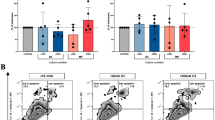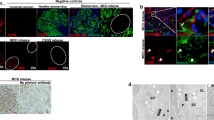Abstract
Background
Minimal change disease (MCD) is the most common cause of nephrotic syndrome in children and is associated with the expression of CD80 in podocytes and the increased excretion of CD80 in urine. We hypothesized that serum from patients with MCD might stimulate CD80 expression in cultured podocytes.
Methods
Sera and peripheral blood mononuclear cells (PBMCs) were collected from subjects with MCD in relapse and remission and from normal controls. Immortalized human podocytes were incubated with culture media containing patient sera or supernatants from patient and control PBMC cultures. CD80 expression was measured by quantitative PCR and western blot analysis.
Results
Sera collected from patients with MCD in relapse, but not in remission, significantly increased CD80 expression (mean ± standard deviation: 1.8 ± 0.7 vs. 0.8 ± 0.2; p < 0.004) and CD80 protein secretion by podocytes (p < 0.05 between relapse and normal controls). No such CD80 increase was observed when podocytes were incubated with supernatants of PBMC cultures from patients in relapse.
Conclusions
Sera from MCD patients in relapse, but not in remission, stimulated CD80 expression in cultured podocytes. Identifying this factor in sera could provide insights into the pathogenesis of this disorder. No role in CD80 expression by podocytes was found for cytokines released by PBMCs.





Similar content being viewed by others
References
International Study of Kidney Disease in Children (1978) Nephrotic syndrome in children: prediction of histopathology from clinical and laboratory characteristics at time of diagnosis. A Report of the International Study of Kidney Disease in Children. Kidney Int 13:159–165
Shalhoub RJ (1974) Pathogenesis of lipoid nephrosis: A disorder of T-cell function. Lancet 2:556–560
Koyama A, Fujisaki M, Kobayashi M, Igarashi M, Narita M (1991) A glomerular permeability factor produced by human T-cell hybridomas. Kidney Int 40:453–460
Garin EH, Laflam PF, Muffly K (2006) Proteinuria and fusion of podocyte foot processes in rats after infusion of cytokine from patients with idiopathic minimal lesion nephrotic syndrome. Nephron Exp Nephrol 102:e105–112
Greenwald RJ, Freeman GJ, Sharpe AH (2005) The B7 family revisited. Annu Rev Immunol 23:515–548
Reiser J, von Gersdorff G, Loos M, Oh L, Asanuma K, Giardino L, Rastaldi MP, Calvaresi N, Watanabe H, Schwarz K, Faul C, Kretzler M, Davidson A, Sugimoto H, Kalluri R, Sharpe AH, Kreidberg JA, Mundel P (2004) Induction of B7-1 in podocytes is associated with nephrotic syndrome. J Clin Invest 113:1390–1397
Garin EH, Mu W, Arthur JM, Rivard CJ, Araya CE, Shimada M, Johnson RJ (2010) Urinary CD80 is elevated in minimal change disease but not in focal segmental glomerulosclerosis. Kidney Int 78:296–302
Garin EH, Diaz LN, Mu W, Wasserfall C, Araya C, Segal M, Johnson RJ (2009) Urinary CD80 excretion increases in idiopathic minimal-change disease. J Am Soc Nephrol 20:260–266
Shimada M, Araya C, Rivard C, Ishimoto T, Johnson RJ, Garin EH (2011) Minimal change disease: A “Two hit” podocyte immune disorder? Pediatr Nephrol 26:645–649
International Study of Kidney Disease in Children (1981) Primary nephrotic syndrome in children: clinical significance of histopathologic variants of minimal change and of diffuse mesangial hypercellularity. A Report of the International Study of Kidney Disease in Children. Kidney Int 20:765–771
Garin EH, Boggs KP (1987) Effect of peripheral blood mononuclear cells from patients with nephrotic syndrome on uptake of 35sulfate by glomerular basement membrane. Int J Pediatr Nephrol 6:189–194
Saleem MA, O’Hare MJ, Reiser J, Coward RJ, Inward CD, Farren T, Xing CY, Ni L, Mathieson PW, Mundel P (2002) A conditionally immortalized human podocyte cell line demonstrating nephrin and podocin expression. J Am Soc Nephrol 13:630–638
Blau EB, Haas JE (1973) Glomerular sialic acid and proteinuria in human renal disease. Lab Invest 28:477–481
Garin EH, Boggs KP (1985) Effect of supernatants from nephrotic peripheral blood mononuclear cells on 35sulfate incorporation in rat glomerular basement membrane. Pediatr Res 19:836–840
Mundel P, Shankland SJ (2002) Podocyte biology and response to injury. J Am Soc Nephrol 13:3005–3015
Chiron D, Pellat-Deceunynck C, Amiot M, Bataille R, Jego G (2009) TLR3 ligand induces NF-{kappa}B activation and various fates of multiple myeloma cells depending on IFN-{alpha} production. J Immunol 182:4471–4478
Yu H, Ha T, Liu L, Wang X, Gao M, Kelley J, Kao R, Williams D, Li C (2012) Scavenger receptor A (SR-A) is required for LPS-induced TLR4 mediated NF-κB activation in macrophages. Biochim Biophys Acta 1823:1192–1198
Shimada M, Ishimoto T, Lee PY, Lanaspa MA, Rivard CJ, Roncal-Jimenez CA, Wymer DT, Yamabe H, Mathieson PW, Saleem MA, Garin EH, Johnson RJ (2012) Toll-like receptor 3 ligands induce CD80 expression in human podocytes via an NF-kappaB-dependent pathway. Nephrol Dial Transplant 27:81–89
Yap HK, Cheung W, Murugasu B, Sim SK, Seah CC, Jordan SC (1999) Th1 and Th2 cytokine mRNA profiles in childhood nephrotic syndrome: evidence for increased IL-13 mRNA expression in relapse. J Am Soc Nephrol 10:529–537
Lai KW, Wei CL, Tan LK, Tan PH, Chiang GS, Lee CG, Jordan SC, Yap HK (2007) Overexpression of interleukin-13 induces minimal change-like nephropathy in rats. J Am Soc Nephrol 18:1476–1485
Cheung W, Wei CL, Seah CC, Jordan SC, Yap HK (2004) Atopy, serum IgE, and interleukin-13 in steroid-responsive nephrotic syndrome. Pediatr Nephrol 19:627–632
Garin EH, West L, Zheng W (2000) Interleukin-8 alters glomerular heparan sulfate glycosaminoglycan chain size and charge in rats. Pediatr Nephrol 14:284–287
Garin EH, Blanchard DK, Matsushima K, Djeu JY (1994) IL-8 production by peripheral blood mononuclear cells in nephrotic patients. Kidney Int 45:1311–1317
Reiser J, Mundel P (2004) Danger signaling by glomerular podocytes defines a novel function of inducible B7-1 in the pathogenesis of nephrotic syndrome. J Am Soc Nephrol 15:2246–2248
MacDonald NE, Wolfish N, McLaine P, Phipps P, Rossier E (1986) Role of respiratory viruses in exacerbations of primary nephrotic syndrome. J Pediatr 108:378–382
Xatzipsalti M, Kyrana S, Tsolia M, Psarras S, Bossios A, Laza-Stanca V, Johnston SL, Papadopoulos NG (2005) Rhinovirus viremia in children with respiratory infections. Am J Respir Crit Care Med 172:1037–1040
Conflict of interest
We, the authors declare that the results presented in this paper have not been published previously in whole or part, except in abstract format. This work was supported by NIH R01DK080764. The authors declare no conflicts of interest.
Author information
Authors and Affiliations
Corresponding author
Rights and permissions
About this article
Cite this article
Ishimoto, T., Cara-Fuentes, G., Wang, H. et al. Serum from minimal change patients in relapse increases CD80 expression in cultured podocytes. Pediatr Nephrol 28, 1803–1812 (2013). https://doi.org/10.1007/s00467-013-2498-4
Received:
Revised:
Accepted:
Published:
Issue Date:
DOI: https://doi.org/10.1007/s00467-013-2498-4




